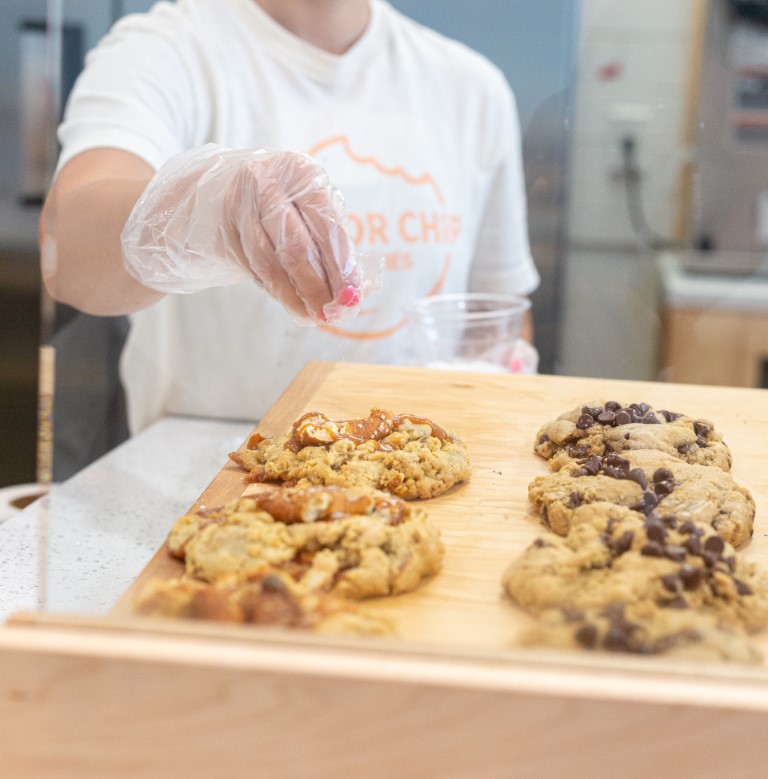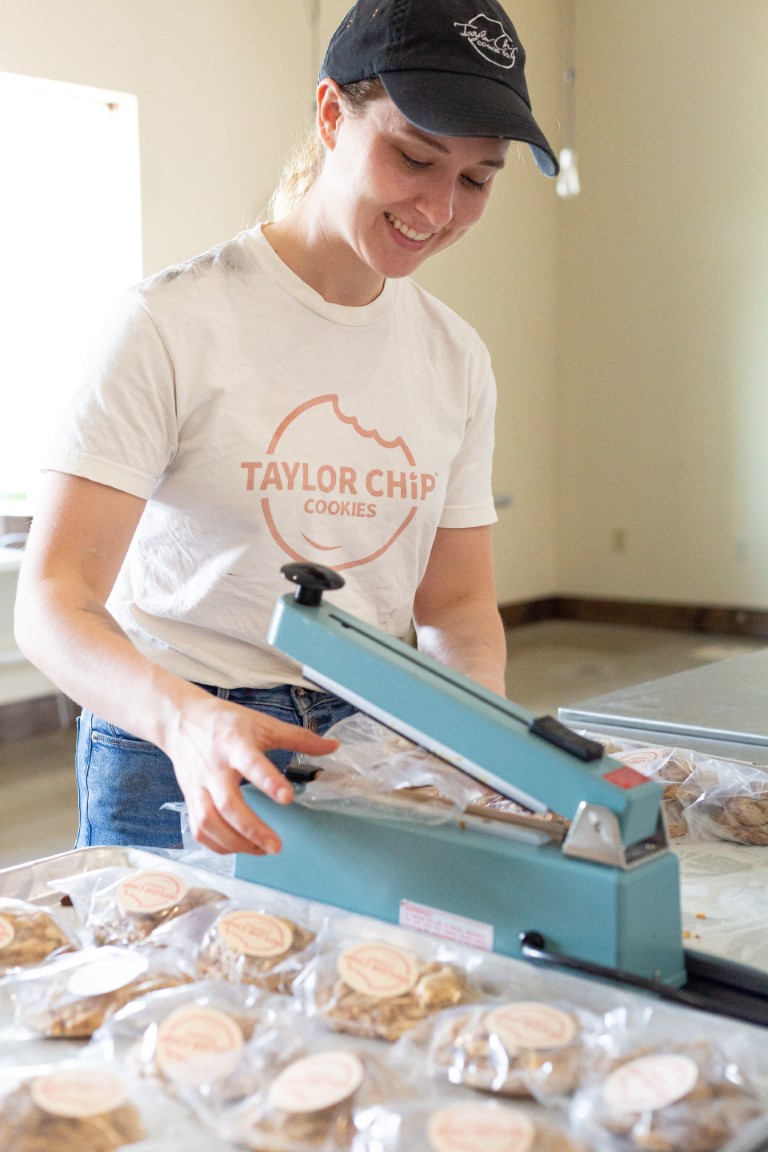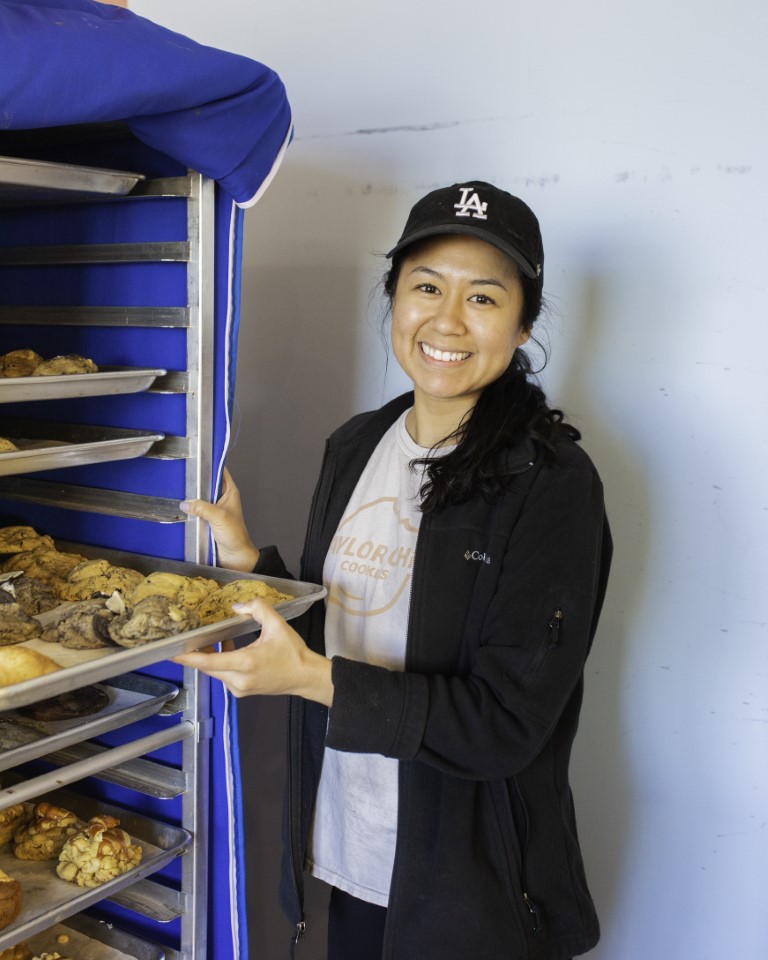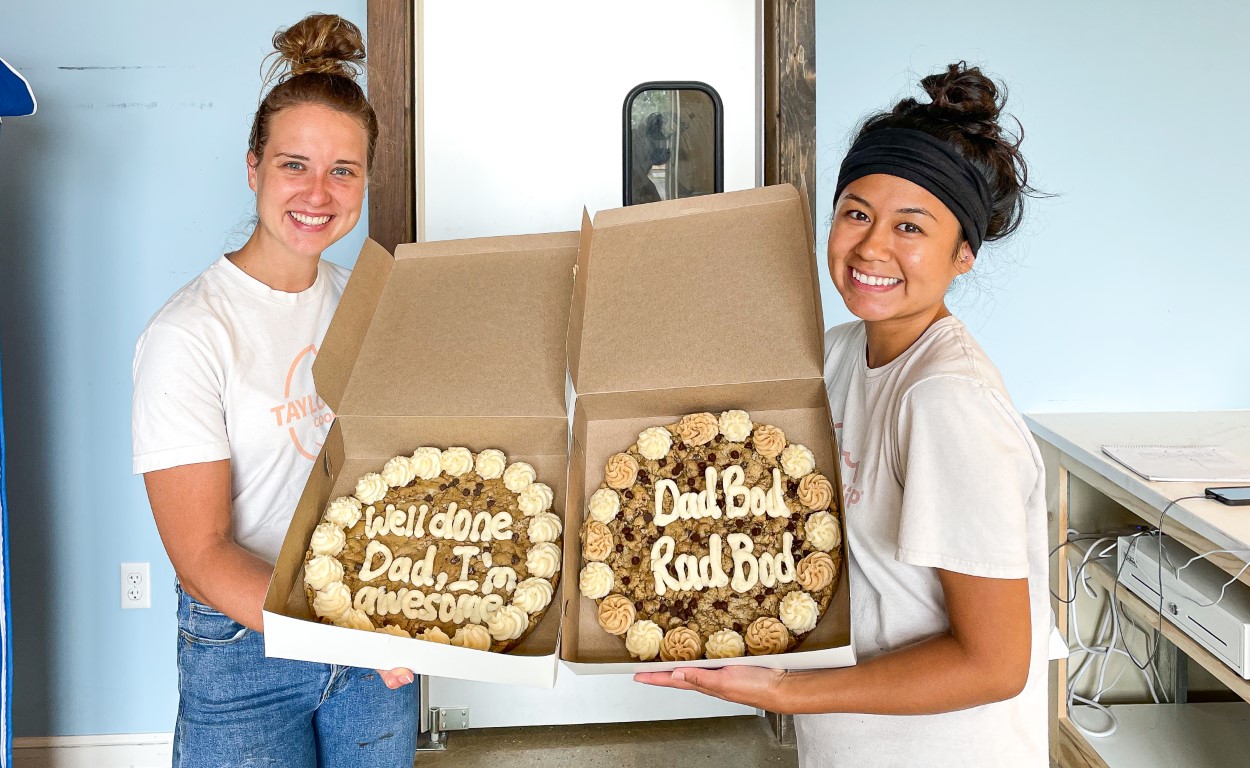To transport frosted cookies effectively, start by ensuring cookies are fully cooled before frosting, allowing adequate drying time for the icing to set. Use sturdy containers like bakery boxes or airtight Tupperware, and avoid stacking cookies directly to prevent frosting damage. If stacking is necessary, use parchment or wax paper between layers. Place cookies in a single layer whenever possible, using dividers to separate different types. During car transport, secure the containers on the floor of the backseat, maintaining a cool temperature to preserve frosting integrity. Keep following these techniques, and you'll master the art of cookie transport.
Key Takeaways
- Allow frosting to fully set before packaging to avoid smudging.
- Use bakery boxes with parchment paper to maintain cookie stability during transport.
- Place cookies in a single layer to prevent frosting damage.
- Secure boxes in the car's backseat, avoiding the trunk to reduce shifting.
- Maintain a cool temperature during transport to preserve frosting integrity.
Types of Frosted Cookies and Their Challenges
When transporting frosted cookies, you'll face different challenges depending on whether you're working with royal icing or buttercream. Royal icing hardens to a solid finish, making it less prone to smudging, but it can be brittle and prone to cracking. Buttercream, on the other hand, is soft and creamy, which means it can easily smear or shift during transport, requiring more careful packing strategies.
Royal Icing vs. Buttercream: Characteristics and Transport Considerations
Choosing the right icing for your cookies is essential, especially when you need to transport them. Royal icing and buttercream cookies each have unique characteristics that impact their transportability. Royal icing, known for its smooth, hard finish, dries quickly, making it an excellent choice for transport. Once dry, it's less likely to smudge or get damaged during transit. To guarantee your royal icing cookies stay intact, use sturdy packaging material and an airtight container to prevent humidity from softening the icing.
On the other hand, buttercream cookies, while delicious and creamy, pose more challenges for transport. Buttercream icing doesn't harden the way royal icing does, making it more susceptible to smudging and deformation. If you opt for buttercream, consider using thicker layers of padding and dividers within your packaging material to minimize movement. Additionally, keep the cookies cool, as buttercream can melt at higher temperatures.
When comparing drying time, royal icing gives you an advantage with its quick setting nature. Buttercream, however, remains soft, requiring more careful handling. Both types of icing can be successfully transported with proper planning and appropriate packaging strategies, guaranteeing your cookies arrive in perfect condition.
Preparing Cookies for Transport
Before you transport frosted cookies, make certain they've had enough time to cool completely and the frosting has set properly. Choose a frosting that remains stable at room temperature to avoid any melting or smudging during the journey. By paying attention to these details, you'll guarantee your cookies arrive in perfect condition.
Cooling and Setting Times
To guarantee your frosted cookies arrive intact and looking their best, it's crucial to allow sufficient cooling and setting times. Start by cooling your freshly baked cookies completely before even thinking about frosting them. If you frost warm cookies, the icing will melt and slide off, sabotaging your hard work.
Once cooled, use icing bags to apply your chosen frosting. For royal icing cookies, allow at least 4 to 6 hours for the icing to set completely. Royal icing dries hard and provides a stable surface, ideal for detailed designs and transport. On the other hand, buttercream sugar cookies require a different approach. Buttercream takes longer to set because it doesn't harden completely like royal icing. You should let buttercream sugar cookies sit at room temperature for several hours, or even overnight, to guarantee the frosting firms up.
Properly setting the frosting guarantees your cookies won't stick to each other or smear during transport. Place the cookies in a single layer on a baking sheet to dry, keeping them in a cool, dry place. Once the frosting has set, your frosted cookies will be ready for the next steps in guaranteeing they arrive at their destination in perfect condition.
Choosing the Right Frosting for Stability
When transporting frosted cookies, selecting the right frosting can make all the difference in maintaining their appearance and integrity. Frosting for cookies should provide stability while complementing both the taste and look of your baked treats. For best results, consider using royal icing recipes, which dry hard and resist smudging. This type of icing is especially suitable for decorated sugar cookies and delicate cookie shapes that need to retain their complex designs during transit.
To choose the best frosting for stability, follow these steps:
- Opt for Royal Icing: Royal icing dries quickly into a solid form, making it ideal for transport. It's widely used for detailed product descriptions and elaborate decorations.
- Consider Buttercream Sparingly: Although delicious, buttercream is softer and more prone to damage. If you must use it, make sure cookies are transported in a cool environment.
- Try Glaze Icing: Glaze icing offers a smooth, glossy finish and dries hard yet slightly flexible, reducing the risk of cracks.
- Use Cream Cheese Frosting with Care: This frosting is less stable but can be used if cookies are kept refrigerated and transported in a secure, cool container.
Packaging Options for Frosted Cookies
Choosing the right packaging for your frosted cookies is essential to keep them intact and looking their best. Consider using bakery boxes for their sturdiness and ease of transport, Tupperware or airtight containers for added protection and freshness, and individual wrapping methods to prevent smudging and sticking. Each option has its own set of benefits and usage tips, which we'll explore to help you make the best choice for your needs.
Bakery Boxes: Benefits and Usage Tips
Bakery boxes offer a reliable and practical solution for transporting frosted cookies, guaranteeing they arrive in perfect condition. These boxes, designed specifically for baked goods, provide a sturdy structure that keeps your frosted sugar cookies safe. They maintain the integrity of your cookies by adding an essential layer of protection during transport.
To maximize the benefits of bakery boxes, consider the following tips:
- Line the Box: Use wax paper or parchment paper to line the bottom of the box, adding an extra piece of cardboard if necessary for added stability.
- Single Layer Arrangement: Place cookies in a single layer to prevent stacking, which can damage the frosting.
- Use Dividers: If you need to transport multiple types of cookies, use cardboard dividers to keep them separated and intact.
- Secure the Box: Confirm the lid is tightly closed and, if needed, tape the edges to prevent any accidental openings during transit.
Tupperware and Airtight Containers
Guaranteeing the freshness and protection of your frosted cookies during transport can be effortlessly achieved with Tupperware and airtight containers. These storage solutions are ideal for maintaining the delicate icing and keeping your treats intact. By using a plastic container with a tight-fitting lid, you can prevent air exposure, which can cause cookies with frosting to dry out or become stale.
Start by selecting a container that fits your batch size, making sure it's deep enough to accommodate multiple layers of cookies. To prevent the cookies from sticking together, place a piece of bubble wrap or parchment paper between the layers of cookies. This cushioning will protect the frosting from smudging and preserve the overall appearance of your creations.
When stacking layers of cookies, guarantee they are evenly spaced and not too crowded, as this can lead to pressure on the frosting. Secure the lid firmly to create an airtight seal, which will lock in moisture and keep out contaminants. Using Tupperware and airtight containers for transporting frosted cookies not only guarantees their freshness but also provides a practical and reusable packaging solution that you can rely on for various occasions.
Individual Wrapping Methods
While Tupperware and airtight containers are fantastic for bulk storage, sometimes you need a more individualized approach for your frosted cookies. Individual wrapping methods guarantee each cookie stays pristine and avoids smudging or damage during transport. Here are some effective techniques:
-
Plastic Wrap: Wrap each cookie individually in plastic wrap. This method provides a tight seal, keeping the frosting intact and preventing moisture loss. It's an excellent option for short-term transport.
-
Wax Paper: Use wax paper to separate cookies within a larger container. Cut small squares of wax paper and place them between each cookie layer. This method prevents sticking and is less likely to disturb the frosting.
-
Bubble Wrap: For extra protection, especially if the cookies are delicate or have elaborate designs, wrap them in bubble wrap. The cushioning effect of bubble wrap helps absorb shocks and prevents breakage.
-
Cello Bags: Place each cookie in a cello bag and seal the top. This method not only keeps the cookies fresh but also provides a clear view of the decorated treats, making them perfect for gifting.

Choose Your Own Delightfully Perfect Cookies.
With almost 30 flavors to choose from, you can make your box as unique as you are.
Stacking and Layering Techniques
When transporting frosted cookies, knowing when to use a single layer versus stacking is essential for maintaining their appearance and taste. If you opt for stacking, make sure each layer is separated with parchment or wax paper to prevent smudging and sticking. By securing layers this way, you can transport multiple cookies without compromising their complex designs.
Single Layer vs. Stacking: When and How
Transporting frosted cookies involves deciding whether to stack them or lay them out in a single layer, and getting this right can mean the difference between beautifully intact treats and a sugary mess. For more fragile cookies with detailed cookie frosting, a single layer is often the best choice. This method minimizes pressure on the cookies, reducing the risk of damage.
When stacking is necessary due to space constraints, it becomes a delicate process. To safely stack your cookies, consider using divider trays. These trays help separate layers, providing protection from direct contact and potential smudging. Here's a quick guide to help you decide:
- Single Layer: Ideal for cookies with delicate frosting or those that are particularly fragile. Confirm each cookie is spaced adequately.
- Stacking: Use only when space is limited. Place divider trays between layers to protect the frosting.
- Cookies per Layer: Limit the number of cookies per layer to avoid overcrowding, which can lead to breakage.
- Fragile Cookie Considerations: If the cookies are highly delicate, prioritize single-layer transport to maintain their pristine condition.
Securing Layers With Paper
To guarantee your frosted cookies arrive in perfect condition, securing each layer with paper is a smart technique. Start by placing a piece of tissue paper at the bottom of your cookie box to create a cushioning layer. Next, arrange your cookies in cello bags to prevent direct contact with each other and reduce the risk of smudging the frosting.
After placing the first layer of cookies, add another piece of tissue paper or crinkle paper on top. This will act as a buffer between stacked layers, protecting your delicate treats from damage. When adding additional layers, repeat the process of placing cookies in cello bags, followed by a piece of tissue paper or crinkle paper.
Once all your cookies are firmly layered, close the cookie box and use packing tape to seal it. This guarantees the box remains closed during transport, preventing any accidental openings that could harm your cookies. To further secure the package, consider wrapping the entire box with another layer of packing tape.
Transporting Cookies by Car
To guarantee your frosted cookies arrive in perfect condition, you need to secure them properly in your vehicle by placing them in sturdy containers and using non-slip mats to prevent shifting. Drive carefully, avoiding sudden stops and sharp turns, which can cause the cookies to jostle and potentially ruin the frosting. Using climate control to maintain a cool temperature can also help preserve the integrity of your beautifully decorated treats.
Securing Cookies in the Vehicle
When it comes to driving with frosted cookies, guaranteeing they arrive intact requires some careful planning. Start by selecting a sturdy container of cookies that prevents them from shifting during transit. Using boxes with paper dividers can help keep individual cookies upright and separated.
Here's a step-by-step guide to secure your cookies in the vehicle:
- Use Adjustable Trays: Place the container of cookies on adjustable trays. This allows you to create a flat, stable surface in your car.
- Line with Tissue Paper: Inside the container, use a sheet of tissue paper to cushion the cookies and prevent them from sliding.
- Secure the Box: Place the box in a secure spot like the floor of the backseat, avoiding the trunk where items shift more.
- Avoid Overstacking: Guarantee that the boxes aren't stacked too high, as this can cause them to topple over when you make turns or stop suddenly.
Driving Tips for Smooth Transport
Maneuvering the roads with a car full of frosted cookies can be a bit tricky, but with some careful driving, you'll guarantee they arrive in perfect condition. The first driving tip is to make sure you accelerate and brake gradually. Sudden stops or starts can cause the cookies to shift and potentially damage the complex cookie designs.
Next, try to avoid sharp turns. When transporting cookies, taking corners slowly and widening your turns can help keep your frosted cookies from sliding around. If possible, plan your route to stick to smoother roads and avoid potholes and rough terrain, which can jostle the cookies and ruin your cookie decorating efforts.
Maintaining a consistent speed is also essential. Use cruise control on highways to minimize the risk of sudden speed changes. When parking, find a flat, level surface to prevent the cookies from tilting.
Lastly, consider the temperature within your car. High heat can cause the frosting to melt, so keep the air conditioning on if you're driving on a hot day. By following these driving tips, you'll make sure that transporting cookies is a smooth process, preserving your beautiful cookie designs.
Troubleshooting and Maintenance
If your cookies shift or break during transport, you can use extra frosting to patch them up, guaranteeing they still look presentable. To manage temperature changes, consider using insulated containers or ice packs to keep the cookies cool, preventing the frosting from melting. By addressing these issues, you'll guarantee your cookies arrive in perfect condition.
Dealing with Shifted or Broken Cookies
Despite your best efforts, frosted cookies can sometimes shift or break during transport, leading to frustration and disappointment. To address these issues, follow these steps to guarantee your cookies arrive intact.
-
Keep Cookies Flat: Place your beautiful sugar cookies on a flat surface within your packaging. Use parchment paper or wax paper between layers to prevent them from sticking together.
-
Secure Packaging: Use a box with bubble wrap to cushion your cookies for shipping. Line the bottom and sides of the box with bubble wrap and place the cookies in a single layer. Add additional bubble wrap on top to minimize movement.
-
Reassemble Broken Pieces: If a cookie breaks, don't panic. Use a small piece of tape to carefully reassemble the pieces. This temporary fix will keep the cookies together until they're ready to be enjoyed.
-
Prevent Shifting: Fill any gaps within the box with tissue paper or more bubble wrap to prevent cookies from shifting during transport. Guarantee the box is tightly packed but not overly compressed, as too much pressure can cause breakage.
Managing Temperature Changes During Transport
Transporting frosted cookies can be tricky, especially when temperature changes come into play. To guarantee your cookies arrive intact and fresh, you must manage temperature fluctuations carefully. Start by making sure the frosting is completely set before packaging; this drying process prevents smudging and melting.
Next, use a heat sealer to make your cookies airtight, which helps maintain their freshness and protects them from humidity and heat. This step is critical, especially if shipping time is long or if you're dealing with the heat of summer. When cookies are airtight, they're less likely to absorb moisture or become stale.
Consider using insulated packaging, such as thermal bubble mailers or coolers, to shield your cookies from extreme temperatures. Adding cold packs can also help maintain a stable temperature, but be cautious—they must be well-wrapped to avoid condensation affecting the cookies.
Lastly, try to choose the fastest shipping option available. The less time your cookies spend in transit, the lower the risk of temperature-related issues. By following these steps, you'll guarantee your frosted cookies arrive at their destination in perfect condition.
Best Practices for Successful Cookie Transport
For successful cookie transport, remember key tips like using sturdy containers, layering with parchment paper, and packing snugly to prevent shifting. Don't hesitate to try different methods and see what works best for you. Share your experiences and learn from others to continually improve your cookie transport techniques.
Key Takeaways and Tips
When transporting frosted cookies, a few best practices can save your baked goods from disaster. By following these simple tips, you can guarantee that your cookies arrive intact and looking as delicious as when they left your kitchen.
-
Use Sturdy Containers: Opt for durable containers that provide ample space between layers. Stacking too many frosted cookies can cause them to smudge or break.
-
Layer with Parchment Paper: Place a sheet of parchment paper between each layer of cookies. This prevents the frosting from sticking to other cookies or the container itself.
-
Opt for Cellophane Bags: For individual cookies, consider using cellophane bags. They're cost-effective and offer an extra layer of protection. Seal them tightly to keep the cookies fresh and the frosting intact.
-
Consider the Cost of Packaging: Investing in proper packaging can save you from potential cookie disasters. While it might increase the overall cost, it guarantees your frosted cookies arrive in perfect condition.
Incorporating these cookie tips into your routine will make transporting your favorite cookie recipe a breeze. Remember, the right preparation and tools are key to delivering perfectly frosted cookies every time.
Encouragement to Experiment and Share Experiences
Now that you're armed with practical tips for transporting frosted cookies, it's time to embrace a spirit of experimentation and community sharing. Don't hesitate to try different methods and materials to find out what works best for you. Use food-safe containers to guarantee your cookies remain fresh and uncontaminated. A beautiful paper box can add a touch of elegance to your presentation, whether you're giving them as a gift or simply sharing them with friends.
When wrapping your cookies, consider using gift wrap to make the package more festive. You can line the box with a piece of newsprint for added protection and to prevent shifting during transport. These simple steps can make a big difference in keeping your cookies intact and looking their best.
Share your experiences with others, whether through social media, baking forums, or community events. Your perspectives might help someone else perfect their cookie transport technique. Encouraging others to experiment and share their methods cultivates a supportive baking community. By sharing what you've learned, you contribute to a wealth of knowledge that benefits everyone, guaranteeing that frosted cookies arrive at their destination in perfect condition.
Why Trust Our Cookie Transport Insights?
At Taylor Chip, our expertise in cookie craftsmanship goes beyond just baking. Since 2015, Sara and Dougie Taylor have been perfecting the art of creating and handling delicate, frosted cookies. What started as a shared passion during their dating years has evolved into a deep understanding of every aspect of cookie production, including the crucial step of transportation.
Our journey of trial and error in perfecting cookies has given us unique insights into the challenges of maintaining their quality during transit. We've experienced firsthand the pitfalls of improper packaging and the disappointment of damaged frosting. These experiences have driven us to develop and refine techniques that ensure our cookies arrive in perfect condition, whether they're being delivered across town or shipped to customers nationwide. Our commitment to excellence extends from the mixing bowl to the moment our cookies reach their final destination.
By sharing our hard-earned knowledge about transporting frosted cookies, we're not just offering tips – we're providing you with strategies born from years of hands-on experience and continuous improvement. Our expertise allows us to address the nuances of different frosting types, packaging materials, and transportation methods, ensuring that every piece of advice we offer is practical, tested, and effective. Trust in our insights to help you deliver your frosted creations with the same care and quality that we've come to be known for at Taylor Chip.
Frequently Asked Questions
How Can I Prevent the Frosting From Melting in Hot Weather?
You can prevent the frosting from melting in hot weather by using insulated containers and ice packs. Avoid direct sunlight and keep the temperature controlled. Make sure the environment stays cool during transport.
What Tools Are Essential for Decorating and Transporting Frosted Cookies?
You'll need piping bags, icing tips, and a cooling rack for decorating. For transporting, use a sturdy container, parchment paper to separate layers, and ice packs to keep them cool, especially in hot weather.
Can Frosted Cookies Be Frozen for Future Transport?
Yes, you can freeze frosted cookies for future transport. Place them in a single layer on a baking sheet to freeze. Once solid, transfer to an airtight container with parchment paper between layers to prevent sticking.
How Long Can Frosted Cookies Stay Fresh During Transport?
During transport, frosted cookies can stay fresh for up to three days if you pack them properly. Use airtight containers and separate layers with parchment paper to prevent smudging and guarantee they arrive in perfect condition.
Are There Any Eco-Friendly Packaging Options for Transporting Cookies?
You're looking for eco-friendly packaging options. Try using biodegradable boxes, reusable tins, or compostable bags. They're great for the environment and still protect your cookies during transport. Avoid plastic to reduce your carbon footprint.
Conclusion
In conclusion, transporting frosted cookies successfully requires careful preparation and attention to detail. By understanding the challenges of different cookie types, preparing them properly, and choosing the right packaging, you can guarantee your cookies arrive intact. Use effective stacking and layering techniques, and consider the specifics of transporting by car to minimize movement. With these best practices, you'll be well-equipped to troubleshoot any issues and maintain the quality of your frosted cookies during transport.











